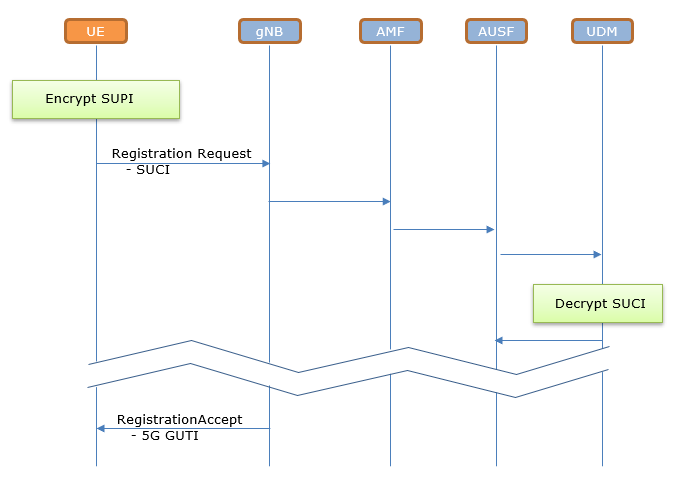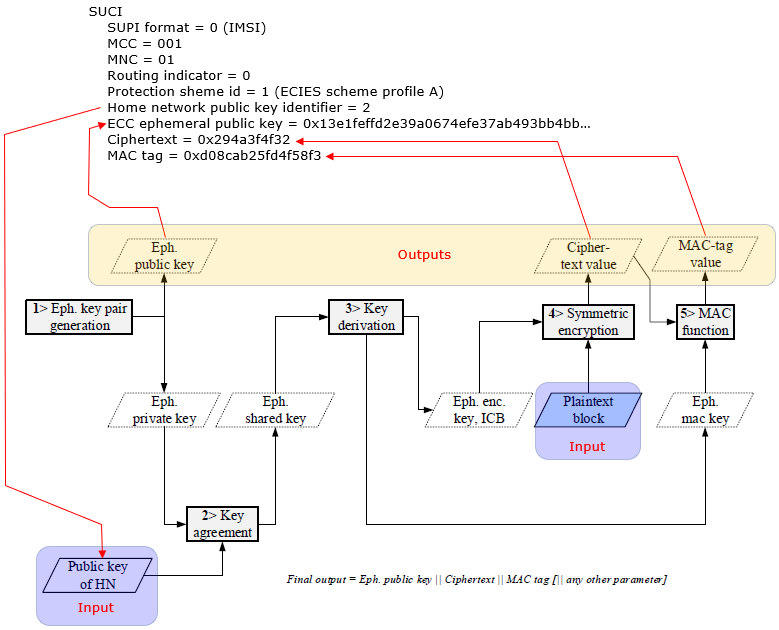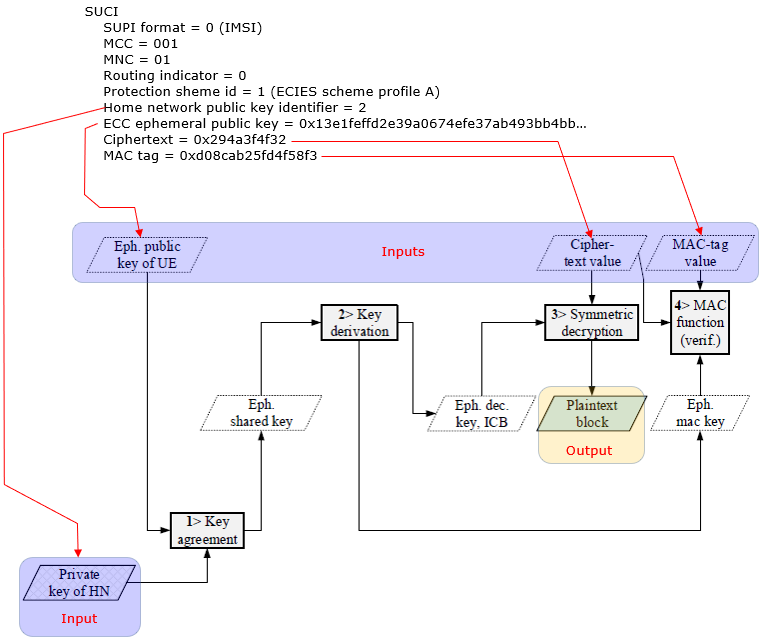|
|
||
|
The UE ID in a 5G network is used to uniquely identify the UE and establish secure communication between the UE and the network. The UE ID can be a temporary identifier (SUCI) or a permanent identifier (SUPI), and it is used in various network procedures, such as registration, authentication, and key agreement. Basically the intended role of UE ID is same in 5G and in other legacy technology (4G, 3G etc), but UE IDs in 5G is extended and enhanced to compensate for various issues / vunerabilities observed in previous technologies. In this note, I want to talk about what type of new UE IDs are introduced in 5G and how they can handle various issues we faced in previous technology.
Types of UE IDsThere are many different types of UE IDs in 5G. A simple way to check on the type of UE IDs in 5G would be to check on the list of UE IDs used in 5G Registration message which are listed as below. You would see some of the IDs same as in 4G (e.g, IMEI, IMEISV) but most of others are new types introduced in 5G (e.g, SUCI, 5G-GUTI etc) SUCI SUCI (SUPI Format = IMSI) mcc mnc Routing Indicator (16 bit, 4 digit) Protection scheme Id (4 bit) Home network public key identifier (8 bit) Scheme output (n Bytes) SUCI (SUPI Format = Network specific identifier) Type of identity (3 bit) SUCI NAI (n bytes) 5G-GUTI mcc mnc AMF Region ID (8 bit) AMF Set ID (10 bit) AMF Pointer (6 bit) 5G TMSI (32 bit) IMEI 5G-S-TMSI AMF Set ID (8 bit) AMF Pointer (8 bit) 5G - TMSI(32 bit) IMEISV NOTE : We have GUTI in 4G as well. What is the differeces between 4G GUTI and 5G GUTI ? The main difference between 4G GUTI and 5G GUTI is that the 5G GUTI contains a temporary identifier (SUCI) that provides enhanced security and privacy features, while the 4G GUTI contains the IMSI which can be used to track a user's location and identity. Additionally, the 5G GUTI is used to identify the UE within a specific network slice, while the 4G GUTI is used to identify the UE within a specific PLMN. The main differences among these IDs are the purpose for which they are used and their scope of use. The IMSI and TMSI are primarily used by the network to identify and authenticate the device, while the 5G-GUTI provides improved security and privacy. The IMEI is used by the network to identify the device and may be used for additional purposes such as blocking stolen devices. Each of these IDs has its own unique characteristics and advantages, and their use may vary depending on the specific requirements of the network and the device. Differences between 4G UE ID and 5G UE ID ?In general, 5G UE ID is more complex and provides improved security and privacy compared to 4G UE ID. Main reasons behind these differnces comes from the differnces of network architecture and from the motivation for improved security protection. Followings are some of the important differneces between 4G UE ID and 4G UE ID. How SUPI turn into SUCI ?Now I understand a few important things about SUCI as listed below.
Now a question arises in my mind. RegistrationRequest is the first NAS message from UE to network and there is no information shared between UE and Network at this point. How can the network decrypt SUCI into SUPI when it recieves it ? In simple words, the logic is similar to Authentication process. It can be described breifly as below.
Now let's look into this process a little bit more in detail. I am not an expert in encryption. So I would just to write down the overview of the process and do not have detailed knowledge on the encryption and decryption algorithm itself. Overall signaling flow with SUCI can be illustrated as below.
What's happening on UE side ?Inside of UE, the process of encrypting SUPI into an encrypted information called SUCI. UE can use a specific algorithm from a list of a few different predefined algorith. Following is the illustration of showing the overview of ECIES based encryption algorithm happening in UE. < 33.501-Figure C.3.2-1: Encryption based on ECIES at UE >
What's happening on Network side ?Once SUCI is transmitted by UE and received by Network. The network has to decode it notified by UE with information elements : Protection Scheme ID. Following is the illustration of showing the overview of ECIES based decryption algorithm happening in Network. < 33.501-Figure C.3.3-1: Decryption based on ECIES at home network >
RegistrationRequest / RegistrationAcceptOnce UE encrypted SUPI into SUCI, it would send it to network via RegistrationRequest message at 5GS mobile identity. NOTE : It is not mandatory in terms of 3GPP for UE to use SUCI. It is allowed to use any type of UE IDs shown here. Which type of ID should be used is determined by the requirement from Network Operator and USIM configuration. SUCI SUCI (SUPI Format = IMSI) mcc mnc Routing Indicator (16 bit, 4 digit) SUCI (SUPI Format = Network specific identifier) Type of identity (3 bit) SUCI NAI (n bytes) 5G-GUTI mcc mnc AMF Region ID (8 bit) AMF Set ID (10 bit) AMF Pointer (6 bit) 5G TMSI (32 bit) IMEI 5G-S-TMSI AMF Set ID (8 bit) AMF Pointer (8 bit) 5G - TMSI(32 bit) IMEISV IdentityRequestIf UE has not used SUCI at RegistrationRequest and Network wants to know of SUCI, Network can request UE to to inform SUCI by sending IdentityRequest with SUCI. Bits 3 2 1 0 1 0 5G-GUTI 0 1 1 IMEI 1 0 0 5G-S-TMSI 1 0 1 IMEISV 1 1 0 MAC address 1 1 1 EUI-64 IdentityResponse with SUCIIf network request UE to send SUCI via IdentityRequest, UE should send IdentityResponse with SUCI in the format shown below. SUCI SUCI (SUPI Format = IMSI) mcc mnc Routing Indicator (16 bit, 4 digit) SUCI (SUPI Format = Network specific identifier) Type of identity (3 bit) SUCI NAI (n bytes) Quote from 24.501-Table 9.11.3.4.1: 5GS mobile identity information element
Example 01 > SUCI with ECIES-A in RegistrationRequestFollowing is an example of SUCI being used in real communication between UE and a Network. (NOTE : This is an example from Amarisoft Callbox and Amarisoft UEsim) Protocol discriminator = 0x7e (5GS Mobility Management) Security header = 0x0 (Plain 5GS NAS message, not security protected) Message type = 0x41 (Registration request) 5GS registration type: Follow-on request bit = 1 Value = 1 (initial registration) ngKSI: TSC = 0 NAS key set identifier = 7 5GS mobile identity: UE security capability: 0xe0 (5G-EA0=1, 128-5G-EA1=1, 128-5G-EA2=1, 128-5G-EA3=0, 5G-EA4=0, 5G-EA5=0, 5G-EA6=0, 5G-EA7=0) 0xe0 (5G-IA0=1, 128-5G-IA1=1, 128-5G-IA2=1, 128-5G-IA3=0, 5G-IA4=0, 5G-IA5=0, 5G-IA6=0, 5G-IA7=0) Example 02 > SUCI with Null Algorithm in Identity ResponseFollowing is an example of SUCI being used in real communication between UE and a Network. (NOTE : This is an example from Amarisoft Callbox and Commerical UE) Protocol discriminator = 0x7e (5GS Mobility Management) Security header = 0x1 (Integrity protected) Auth code = 0xd6ead5fa Sequence number = 0x0a Protocol discriminator = 0x7e (5GS Mobility Management) Security header = 0x0 (Plain 5GS NAS message, not security protected) Message type = 0x5c (Identity response) Mobile identity:
Reference
|
||


